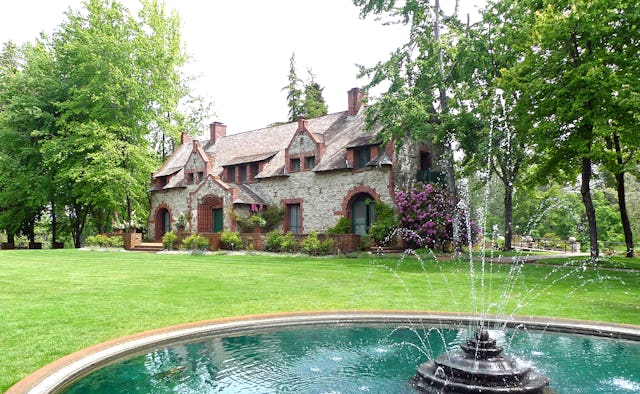Visiting My Local State Park Made Me Appreciate Life

For five years I had thought Empire Mine State Park was a place people walked their dogs, which just happened to be near an old gold mine. And yes, apparently there was a place to walk dogs around there, but it was on some trails that were related to Empire Mine State Park but did not comprise the entirety of it.
It was apparently a whole complex, with some of the old gold mine intact, a little museum, and the mansion where the rich mine owners—the Bourn family, of the San Francisco Bourns—lived.
We walked around the museum part—the part where things are officially behind glass —first. One room was full of pictures and biographies of important Empire Mine people. The biographies were mostly all the same: This guy lived in San Francisco for a while and he was kind of rich there but then he came up here and got more rich.
I didn’t really want to look at the replica of the mine, made from plastic tubes, but my boyfriend insisted. Each inch of tubing represented 800 feet of mine. They had built a little model of the town, as it is now, to give a sense of scale and scope to the miles and miles and layers and layers of mine tunnels under downtown Grass Valley and beyond.
Different sections of the tubing would light up as a recorded narration described them: “This is the entrance.” “This was where the miners descended x far in y seconds.” “This is where they got in another dangerous contraption that took them even x feet deeper.”
Despite my having been practically forced to look at the mine model, it was well worth it. I could have gone my whole life thinking that the mine was just some sort of Walgreen-sized area underneath where we stood, and while that wouldn’t have killed me, it was better that I knew the truth.
In the other room were glass cases of “minerals from all over the world” and information about how minerals have lots of Important Industrial Uses. It made me sad to think about museum officials worrying that they needed to pad out the gold information with other things that were not gold but had qualities loosely in common with gold.
The grounds were New England-esque, with very green grass like neither of us had seen in months, and massive, stately trees (don’t ask me what kind). A round fountain spewed water, hopefully recycled, up toward the blue sky.
Swimming pools are the best—and possibly only—evidence that God walks among us.
We paused now near the mansion’s large swimming pool, which was fed by a stream of water exiting the mouth of a sculpted stone mountain lion, and went down a series of steps built into the hill. The water in the pool was brown and murky. I would really have liked to see this pool with real pool water—looking more Architectural Digest-y than state park-y—and asked my boyfriend if he had the same hankering. He said that he did not. This made me feel a little alone in the world, since I think swimming pools are the best—and possibly only—evidence that God walks among us.
This feeling of loneliness continued as we moved on to some large warehouse-like buildings, replicas of the buildings where workers did the carpentry and blacksmithing to maintain the mine (Empire Mine opened in the 1850s and ceased operations in the 1950s, and much of it was torn down).
Even though I know that if we didn’t have infrastructure we would all be dead, I really resent the pressure to think about it.
I can’t stand machines and tools, but some people, especially people that are guys, can just stare at them forever. It would all be okay if I could just let myself settle into the gender stereotype, but my misery at looking at things like lathes and belts and Pelton Wheels (I have had Pelton Wheel fatigue for several years) ends up extending from mere boredom into guilt and shame because even though I know that if we didn’t have infrastructure we would all be dead, I really resent the pressure to think about it.
This really came to a head in the blacksmith building when a volunteer began talking to us. He talked to us for quite a while. In reality he talked to us for only about fifteen minutes, but because he was talking about melting metal it felt like much longer.
The whole time he was talking I was telling myself, learn something, learn something. But I just didn’t care. Yeah, so people used to make everything by hand. Yes, they used to light things with candles. Yes, this was theoretically fascinating to contemplate, but only, it seemed, theoretically.
The whole time he was talking I was telling myself, learn something, learn something.
The man picked up a big steel rod and set it on his shoulder. He showed us how the end of the rod had been smithed into a screw shape. “And so,” he explained, “One of the men would have this on his shoulder, like so, and the other men would stand behind him, and take turns whacking at the end of this with a sledgehammer, and the screw would slowly work its way into the rock.”
I looked at my boyfriend. We shook our heads. We were speechless. “I knew that I didn’t really know how gold got mined…” I began.
“Can you imagine doing that your whole life?” I said.
“No,” he said. “I really can’t.”
That night, watching yet more television, I enjoyed it more, because I felt that it had been earned with knowledge. So what’s the moral of the story? There are actually two. 1. Profound realizations only amaze us for about an hour. 2. When it comes to history, it’s better to be born later.
Photo: vtveen/flickr
This article was originally published on